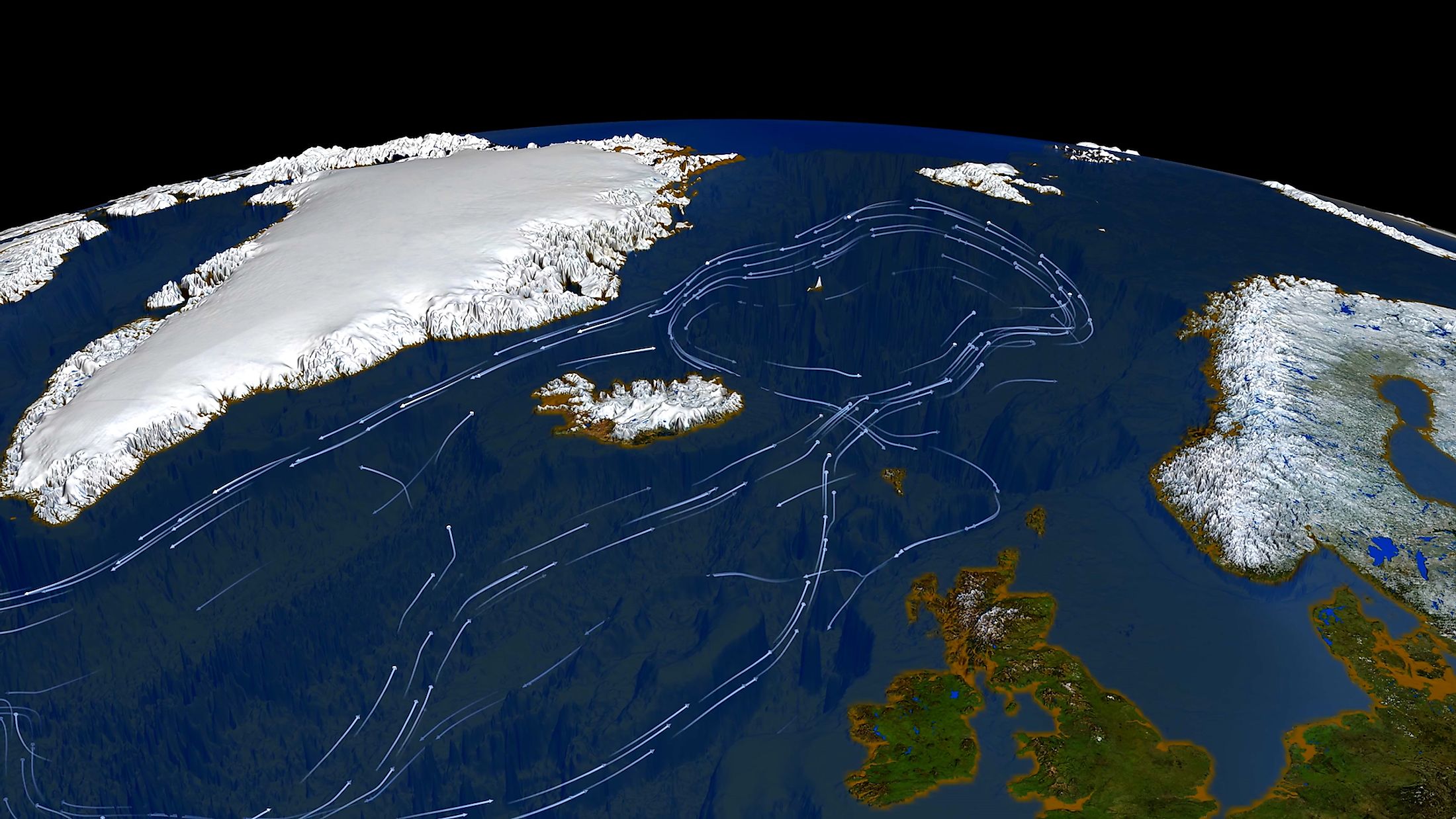
Gulf Stream
The Gulf Stream is a warm and relatively fast-moving current in the Atlantic Ocean that starts at the tip of Florida. It transports warm water in a clockwise motion up from the Gulf of Mexico, along part of the east coast of North America, into the North Atlantic Ocean, and across to northwestern Europe. In the cold climate near Greenland, waters cool, sink, and flow southward again, where they are eventually warmed and continue this circular process.
The movement and current of the Gulf Stream system is so powerful that it can be seen from space and has been notably captured in satellite imagery. Similarly, it is warm enough - or has a significant enough difference in temperature - that infrared images can pick up on its strong thermal gradients.
The Path Of Gulf Stream

The path of the Gulf stream begins upstream of Cape Hatteras, which is where the Florida Current no longer follows the continental shelf. The stream then shifts away from the coast, though the place where it diverts does change depending on the time of year. In Autumn, the stream runs further north before diverting, but the diversion shifts south in the winter and early spring. This shift is not generally a large one, in comparison to the sheer size of the stream, and is thought to be 30-40 kilometers, with some studies suggesting the shift could be as great as 100 kilometers. In comparison, the width of the current ranges from around 100-200 kilometers across.
Gulf Stream Transport
The transport of a stream is the amount of water that circulates itself through the stream and any debris, heat, or salinity associated with it. The Gulf Stream’s transport roughly doubles downstream of Cape Hatteras. This increase is associated with an increase in velocity caused by the deeper waters, and recirculation cells which occur to the north and south of the current. The transport of the Gulf current is at its peak in the fall, and at a minimum in spring, which correlates with the north-south shift of the stream’s path.
Importance Of Gulf Stream
The Gulf Stream has an important role to play in regulating the global climate. Because of the location and flow of the water stream, it brings moderate temperatures to the east coast of North America, Western Europe, and northwest Africa, as well as coastal regions along this route.The warm waters directly influence the temperatures of landmasses nearby, such as Florida, which has a much warmer climate than its neighboring states. This current is also important in warming the European subcontinent. Without this current, southwestern Europe would not maintain the warmer temperatures, and the regional climate would be greatly affected.

Concerns And Climate Change
Data and research show that the Gulf Stream has weakened over the last few centuries, meaning its current seems to be slowing down. The stream is thought to be the weakest in 1,600 years. It has lost approximately 15% of its former strength and velocity since the mid-20th century.
Climate change is the suspected culprit, though natural changes may be a factor. Regardless, it is widely believed that melting ice caps in the poles and especially Greenland will disrupt the system due to the increase in cold fresh water in these areas infiltrating the northern part of the stream.
A weaker gulf stream has a significant impact on the world in general. If the Gulf Stream weakens, sea levels along the eastern coast of Florida will rise. The rising is because warmer waters do not sink as colder ones do, and a slower stream does not move these waters away from land edges, resulting in a build-up of warm water along the coast.
The slow current and the addition of colder water from Greenland will also result in colder winters across northern Europe, as the gulf stream will not have its usual warming effect on the coastal areas there. In the same way, if the stream slows down or breaks down, the warmer waters around Florida and the eastern coast of North America will not be transported towards Europe, and the temperatures in the U.S. will likely rise.
Aside from climate, the Gulf Stream also brings fish and marine life to certain areas. For example, the Gulf Stream’s warm waters around the Florida peninsula ensure a high fish population in the area. Migratory species such as swordfish, mahi-mahi, blue marlin, and sailfish are brought much closer to shore in these regions as the Gulf Stream hugs the coast so closely.
It is difficult to pinpoint if and when the Gulf Stream will slow down enough to have drastic effects on the earth, but evidence seems to indicate that this possibility is increasing and becoming more likely. While it isn’t something we see or maybe even notice on a daily basis, the importance of and impact of the Gulf Stream is large and far-reaching.











